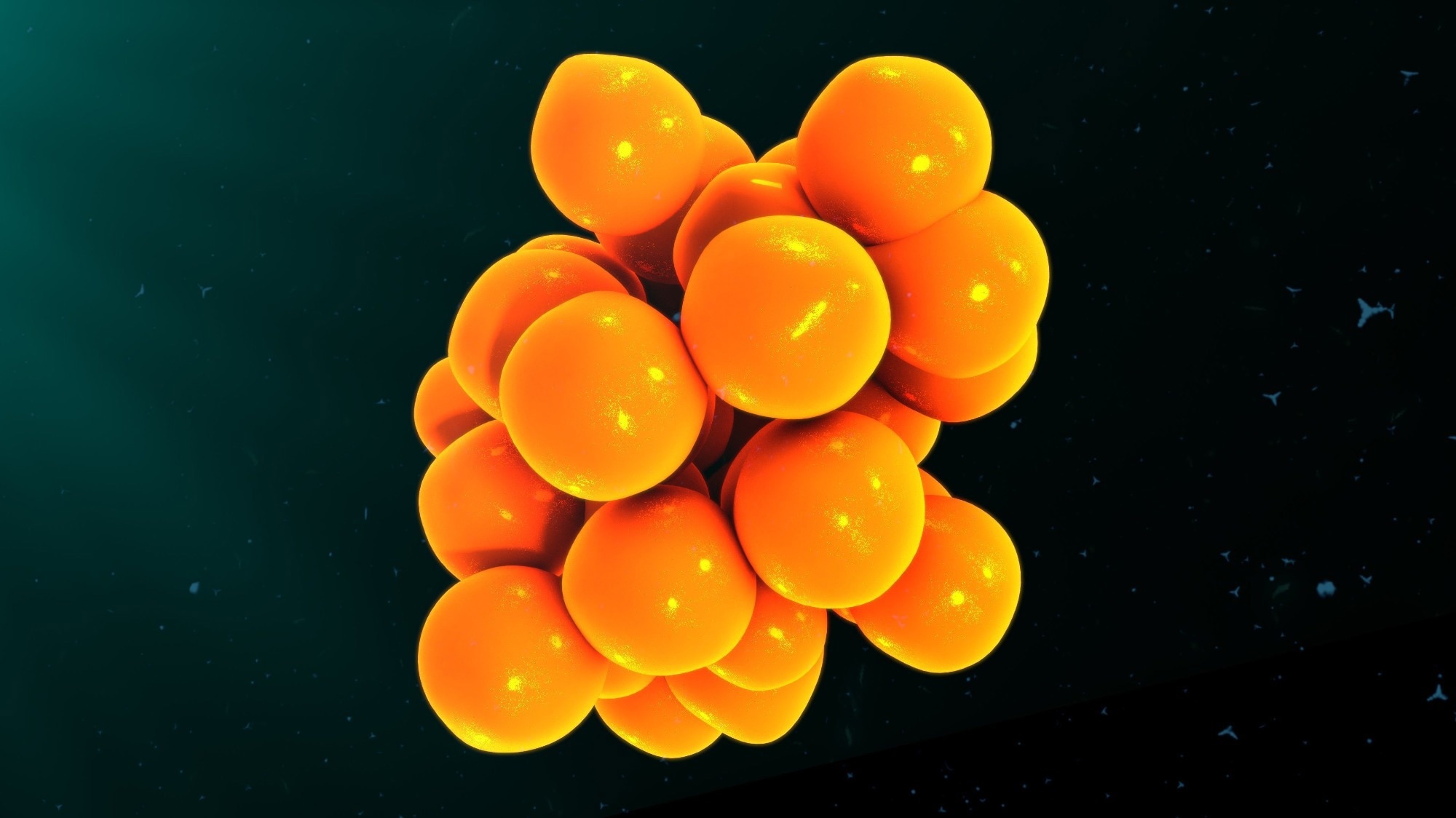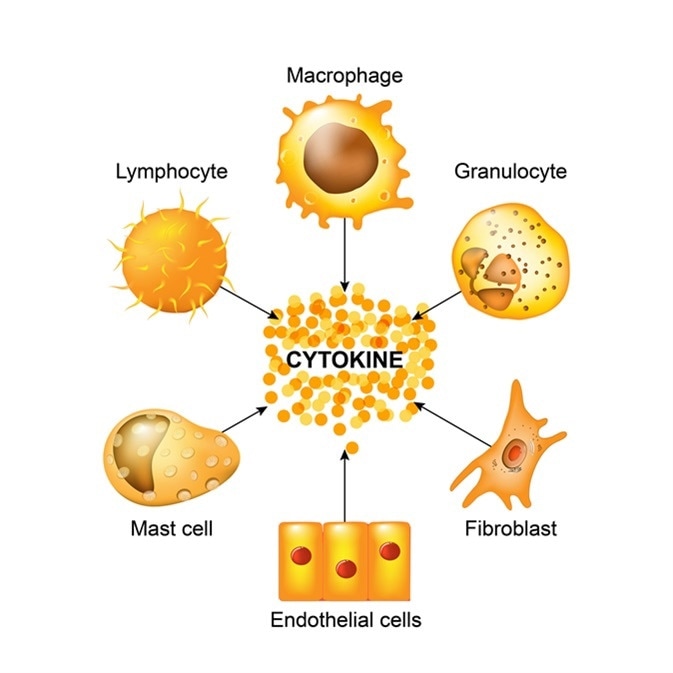Introduction
Chemokines
Interleukins
Interferons
Other cytokines
References
Further reading
Introduction
The term "cytokine" is derived from a combination of two Greek words - "cyto" meaning cell and "kinos" meaning movement. The most current terminology used to describe cytokines is "immunomodulating agents," or agents that modulate or alter the immune system response. Cytokines are small and membrane-bound protein-based cell signaling molecules that aid cell-to-cell communication in immune responses and stimulate the movement of cells towards sites of inflammation, infection, and trauma.
 Cytokines 3d illustration. Image Credit: sciencepics / Shutterstock
Cytokines 3d illustration. Image Credit: sciencepics / Shutterstock
Cytokines transmit various signals for cell survival, proliferation, differentiation, and functional activity, circulate in picomolar concentrations, and may increase in magnitude almost a thousand-fold in response to an infection or inflammation.
Cytokines are crucial in controlling the growth and activity of the immune system cells and blood cells. They can be used to treat cancer and/or help prevent or manage chemotherapy side effects when injected, either subcutaneously, intramuscularly, or intravenously. They also help to boost anti-cancer activity by sending signals that can cause abnormal cell death and increase the longevity of normal cells.
Cytokines can exert systemic as well as local effects. A cytokine's actions may affect the same cell it was secreted from, other nearby cells or may act in a more endocrine manner and produce effects across the whole of the body, such as in the case of fever, for example. Cytokines have a large distribution of sources for their production, with nearly all cells that have a nucleus capable of producing interleukin 1 (IL-1), interleukin 6 (IL-6), and tumor necrosis factor-alpha (TNF-α), particularly endothelial cells, epithelial cells, and resident macrophages.

Cytokines. Image Credit: Designua / Shutterstock
Chemokines
A chemokine is a specific type of cytokine that can make immune cells move toward a target, and there are different kinds of chemokines such as interleukins (ILs), interferons (IFNs), tumor necrosis factors (TNF), and growth factors.
Other cytokines include granulocyte-macrophage colony-stimulating factor (GM-CSF), thymic stromal lymphopoietin (TSLP), leukemia inhibitory factor (LIF), oncostatin M (OSM), ciliary neurotrophic factor (CNTF), cardiotrophin-1 (CT-1) and cardiotrophin-like cytokine factor 1 (CLCF1).
Cytokines act through their receptors to transmit cell survival, proliferation, differentiation, and functional activity signals. Cytokine receptors are a conserved family of about 40 members, including receptors for hormones, IL, IFN, and CSF molecules. The six major cytokine receptor families are type I cytokine receptors, type II cytokine receptors, TNF receptors, IL-1 receptors, tyrosine kinase receptors, and chemokine receptors.
Interleukins
Interleukins are a group of cytokines that act as chemical signals between white blood cells (WBCs). IL-1 plays a crucial role in maintaining tissue integrity, maturing the adaptive immune response and maintaining homeostasis, primarily due to receptor-mediated activation of NF-κB (nuclear factor kappa-light-chain-enhancer of activated B cells). IL-1 stimulates the production of inflammatory cytokines and chemokines by T cells and other immune effector cells.
Natural IL-2 helps immune system cells grow and divide rapidly, and man-made IL-2 has been approved to treat advanced kidney cancer and metastatic melanoma when used as a single drug treatment or in combination with chemotherapy or other cytokines such as IFN-α.
IL-3 plays a vital role in the production of hemopoietic stem cells, mast cells and basophils and through activation of mast cells, basophils and plasmacytoid dendritic cells (pDCs), IL-3 contributes to a range of inflammatory conditions, including delayed-type hypersensitivity reactions, systemic lupus erythematosus (SLE) and lupus nephritis. Overexpression of the alpha-subunit of the IL-3 receptor (IL-3Rα) has been reported in some hematological malignancies, and when this occurs on leukemic stem cells and primary blasts of patients with acute myelogenous leukemia (AML), it correlates with a poor prognosis for patients.
IL-2 and IL-15 are key regulators of lymphocyte homeostasis and function. IL-2 is an autocrine/paracrine factor produced primarily by antigen-activated T cells, promotes the development of T cells and natural killer (NK) cells, and enhances B cell function. IL-15 is produced by activated monocytes and dendritic cells to help in the development of NK cells and memory T cells and has been implicated in inflammatory diseases such as rheumatoid arthritis.
IL-4 and IL-13 are produced by activated T helper type 2 (TH2) cells, mast cells, and basophils. Deregulation of the IL-4 and IL-13-mediated responses have been implicated in the pathology of asthma and allergic diseases. IL-4 helps in B cell differentiation, switching of immunoglobulin isotype, differentiation of T helper cells, and activation of macrophages.
IL-5 stimulates eosinophil production and activation. IL-7 plays a vital role in the development and maintenance of B and T cells, and extracellular matrix remodeling and aberrant IL-7 signaling have caused diseases such as cancer, heart disease, and allergic rhinitis upon overstimulation. IL-10 is expressed by dendritic cells, macrophages, T cells, and eosinophils and has potential clinical relevance in stroke, cardio-protection, pancreatitis, chronic kidney disease, inflammatory bowel disease, graft-versus-host disease, cancer, wound healing, and immune protection against bacterial, nematode, fungal, viral and protozoa infections.
The IL-10 cytokine family (except IL-22) directly regulates the function of immune cells and maintains the balance between overexuberant and beneficial innate immunity responses. IL-22 targets cells of the pancreas, liver, kidneys, joints, and skin. IL-17 is produced by TH17 helper T cells, macrophages, dendritic cells, NK cells, innate lymphoid cells, and epithelial cells and are involved in host defense against bacteria and fungi. IL-17 dysregulation may contribute to inflammatory and autoimmune disorders such as multiple sclerosis, rheumatoid arthritis, psoriasis, uveitis, and ankylosing spondylitis.
IL-33 stimulates T helper (TH)2 cells, mast cells, eosinophils, and basophils to produce type II cytokines such as IL-4, IL-5, and IL-13, which stimulate the proliferation of B and T cells besides other essential immune-modulatory functions. IL-18 is a potent inducer of IFN-gamma, a cytokine with critical immuno-stimulatory functions.
Interferons
Interferons are chemicals that help the body resist viral infections and cancers. Type I IFNs are the body's first line of defense against viral infections, promote viral clearance and regulate innate and adaptive immune responses via activation of the JAK/STAT (Janus kinase/signal transducer and activator of transcription), CRKL (V-crk avian sarcoma virus CT10 oncogene homolog-like), MAPK (mitogen-activated protein kinase) and PI3-kinase (phosphatidylinositol 3-kinase) signaling pathways.
IFN-α boosts the ability of several immune cells to attack cancer cells and may retard the growth of cancer cells directly and the blood vessels that the tumors need to grow. Therefore, IFN-α has been used to treat several cancers such as hairy cell leukemia, chronic myelogenous leukemia (CML), follicular non-Hodgkin lymphoma, cutaneous T-cell lymphoma, kidney cancer, melanoma, and Kaposi sarcoma.
However, an individual on IFN therapy may develop side effects such as flu-like symptoms (chills, fever, headache, fatigue, loss of appetite, nausea, vomiting), reduced WBC counts (and thus increased susceptibility to infections), skin rashes, and thinning of hair. Most side effects (except fatigue) don't last long after cessation of the treatment. Rare long-term effects include damage to nerves, including nerves of the brain and spinal cord.
Other cytokines
GM-CSF is produced by activated T lymphocytes and other immune to regulate the survival, proliferation, differentiation, and functional activation of hematopoietic cells under emergency scenarios such as after infection or blood cell loss. The targets of GM-CSF are myeloid hemopoietic progenitor cells and mature cells such as neutrophils and macrophages, where GM-CSF is emerging as an important regulator of innate and adaptive immune responses.
Elevated expression of GM-CSF has been observed as part of the hyperinflammatory response seen in severely ill coronavirus disease 2019 (COVID-19) patients. In patients with COVID-19, upregulation of pro-inflammatory cytokines such as IL-1, 2, 6, 7, 8, 10, 12, 17, and IL-18 and TNF-α has also been observed, and the immune phenomenon has been described as a cytokine storm.
GM-CSF also plays a critical and non-redundant role in alveolar macrophage function such that loss-of-function mutations that arise in genes encoding the GM-CSF receptor subunits or, more commonly, through the development of GM-CSF neutralizing autoantibodies. TSLP is expressed by epithelial cells in the skin, lung, thymus, and intestine and plays a key role in intestinal immune homeostasis and in mediating allergic inflammatory processes, including those related to asthma and atopic dermatitis.
The non-selective monoclonal antibody (mAb) secukinumab that targets multiple IL-17 cytokines was approved by the FDA (Food and Drug Administration) in 2015 to treat plaque psoriasis, psoriatic arthritis, ankylosing spondylitis, and other autoimmune diseases. Clinical efficacy in treating plaque psoriasis, psoriatic arthritis, and ankylosing spondylitis has also been demonstrated by neutralizing mAbs against IL-17A (ixekizumab, netakimab) and IL-17RA (brodalumab), with ixekizumab, netakimab and brodalumab that obtained FDA approval in 2016, 2019 and 2017, respectively.
To summarize, cytokines are essential protein-based regulators of both the innate and adaptive immune responses, and abnormal cytokine levels or aberrations in their signaling pathways can lead to various diseases, including autoimmune diseases, inflammatory disorders, and cancers, reflecting their importance in normal hematopoiesis and immunity. Continued analysis of cytokines and their receptor complexes aid in driving the development of new drugs that could widen the therapeutic landscape of immunological disorders such as autoimmune conditions, cancers, inflammatory diseases, and viral infections.
Understanding Cytokine Activation
Further Reading